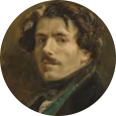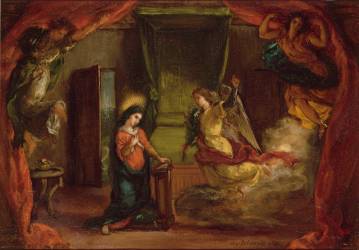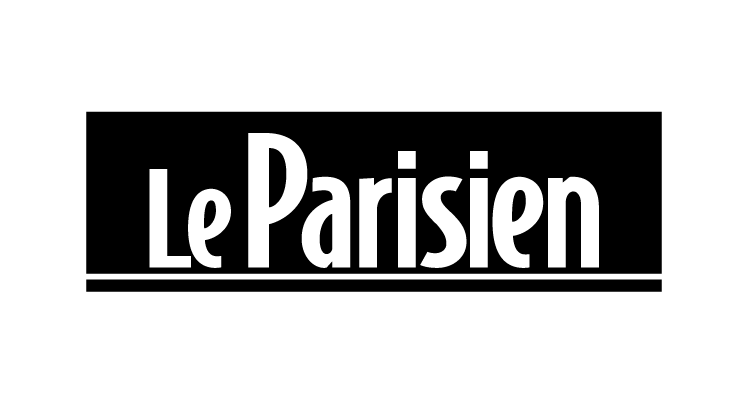Artwork of Eugène Delacroix canvas prints & artprints
A leader in Romantic painting, Eugène Delacroix was of major importance in the history of art, with his paintings known for their bold use of colour and expressive brushstrokes. Discover the most beautiful paintings by the French artist available in the catalogue, including the famous "Liberty guiding the people", a testimony to the French revolts in 1830, the Romantic painting "The death of Sardanapal", or "Roaring lion's head", an expression of his Orientalist period. Treat yourself to an art print by the master of Romanticism, Eugène Delacroix, and find out more about his biography.
Biography of Eugène Delacroix
Delacroix's youth: his path to painting
The son of Charles-François Delacroix, a minister during the Revolution and then a prefect during the First Empire, and Victoire Delacroix, herself the daughter of a great cabinetmaker who worked under Louis XV, Eugène Delacroix was born at the end of the 13th century on 26 April 1978 in Charenton Saint-Maurice, a suburb of Paris, the third child in the family. From an early age, Eugène showed a predisposition for drawing and painting, and at a fairly young age he attended the Lycée Impérial, before being introduced at the age of 17 to the studio of the neoclassical painter Pierre-Narcisse Guérin, thanks to his uncle Henri-François Riesener. He followed his teacher all the way to the Académie des Beaux-Arts, where he learned to copy the major painters of Classicism and Academism. It was during this period that Delacroix drew inspiration for his future paintings, notably from other students, such as Géricault, whom he met in this studio and for whom he posed for the famous painting "The Raft of the Medusa" (1819). It was also during this period, rich in learning for the artist, that he travelled to England, where he immersed himself in watercolours, which were widely used by English painters at the time. These paintings, as well as the classical theatrical scene across the Channel, particularly the plays of William Shakespeare, were major sources of inspiration for the themes and colours used in Delacroix's future compositions. He continued in this vein, and gradually became the leader of Romanticism, creating canvases that gave way to his deepest inspirations, notably with his painting "Scène de Massacres de Scio" (1824), or his oil on canvas "La mort de Sardanapale" (1827), which, despite the virulent criticism it received at the 1827 Salon, along with many other paintings by the artist, became major works of French Romanticism, and were recognised as such by Delacroix's contemporaries, as evidenced by the regular exhibition of his works in the Louvre and the Musée du Luxembourg. Delacroix was often pitted against neo-classical painters such as Jean-Auguste-Dominique Ingres, in whom the painter took a back seat to the commission, giving priority to form, as in the painting "L'Apothéose d'Homère" (1827), in contrast to Romantic painting, which let the artist's feelings express themselves through colour.
Eugène Delacroix or the embodiment of Romanticism
Although his talent received little recognition from his teachers during his formative years, Eugène Delacroix tried his luck at the Salon Officiel, exhibiting his first works there in 1822. He presented one of his most famous paintings, "Dante and Virgil in the Underworld", which sparked a debate among the general public, with some criticising him for being overly inspired by "The Raft of the Medusa" and for his approximate technique that neglected the conservation of the canvas, while others saw in Delacroix the future of French painters and the revival of 19th-century painting. This work is influenced by Michelangelo and Renaissance painting, with its colours and play of light and shadow, in an academic style that heralded the era of the Romantic painters. He continued in this vein, and gradually became the leader of Romanticism, creating canvases that gave way to his deepest inspirations, notably with his painting "Scène de Massacres de Scio" (1824), or his oil on canvas "La mort de Sardanapale" (1827), which, despite the virulent criticism it received at the 1827 Salon, along with many other paintings by the artist, became major works of French Romanticism, and were recognised as such by Delacroix's contemporaries, as evidenced by the regular exhibition of his works in the Louvre and the Musée du Luxembourg. Delacroix was often pitted against neo-classical painters such as Jean-Auguste-Dominique Ingres, in whom the painter took a back seat to the commission, giving priority to form, as in the painting "L'Apothéose d'Homère" (1827), in contrast to Romantic painting, which let the artist's feelings express themselves through colour.
Liberty leading the people: Delacroix's iconic painting
Produced in 1830, Eugène Delacroix presented his greatest pictorial masterpiece, "La liberté guidant le peuple", at the Salon of 1831. With its pure colours transporting the viewer into the uprisings of 1830, this painting depicting a woman in the foreground, an allegory of France and freedom with her Phrygian cap and tricolour flag, leading the men through the barricades in this uprising against the Restoration and King Charles X, is a major composition by the artist and of academic and romantic painting. This historical painting was to inspire a number of artists, including Victor Hugo, who wrote Les Misérables and created his character Gavroche. First exhibited at the Musée du Luxembourg, then withdrawn several times because of the political implications of the message it conveyed, this painting was shown at the Universal Exhibition of 1855, and has been part of the permanent collections of the Musée du Louvre since 1874, showing its importance to the Romantic movement and to the work of Delacroix.
From Morocco to decorative ensembles: the apogee and end of a rich career for Eugène Delacroix
In 1832, Delacroix was invited by King Louis-Philippe's emissary on a trip to Morocco. In North Africa, Delacroix rediscovered a photograph of antiquity as he had imagined it. He drew inspiration from the colours, shapes and landscapes to produce a number of sketches and paintings that would inspire him to embrace Orientalism. He brought back a number of objects and watercolours from this trip, sources of inspiration for the rest of his life. On his return to France, in addition to the new canvases from his Moroccan escapade, he was commissioned to paint murals and civil and religious buildings, notably in Paris, where he decorated the Palais-Bourbon, the Palais du Luxembourg, the Galerie d'Apollon in the Louvre, and the church of Saint-Paul saint-Louis. These decorative ensembles were to be the last major works of his career, before the Romantic painter died in 1863, leaving behind a number of paintings and decorative works that are still regarded today as major works of French and Western painting.
Eugène Delacroix's influence on the world of painting
Eugène Delacroix was well known for his paintings of romantic scenes and historical events. He strongly influenced the world of painting, from the use of colour to the way light was used. Delacroix's use of light is also remarkable, as he showed how it could be manipulated to convey an emotion or mood, something that was still uncommon in the artistic movements of the time. Impressionist painters such as Claude Monet, Edgar Degas and Édouard Manet, and Pointillist painters such as Vincent Van-Gogh, drew inspiration from Delacroix in their use of colour and light. Whether at the Louvre Museum in Paris or the Musée des Beaux-Arts, or at the Musée National Eugène Delacroix, which is entirely dedicated to him in the heart of Paris, Delacroix's work has been a major influence on the history of French painting.
Learn more about the life and the works of Eugène Delacroix.
















































































































































